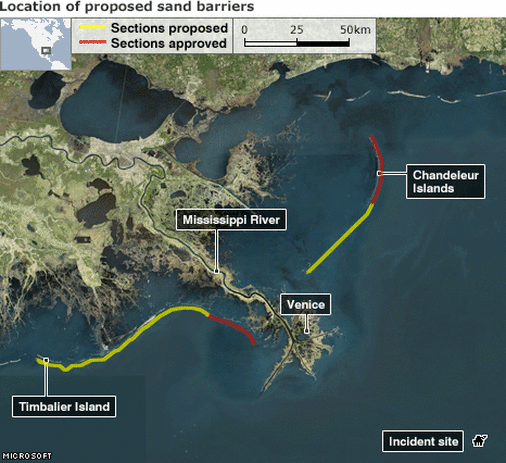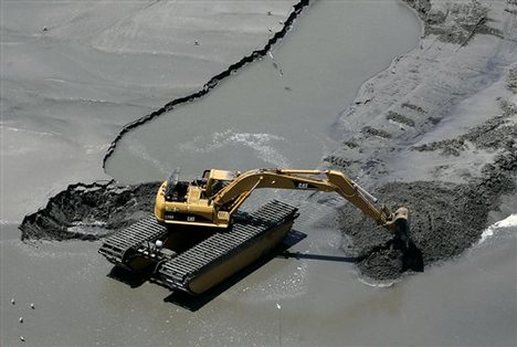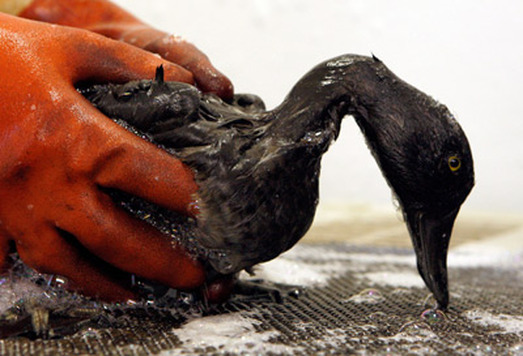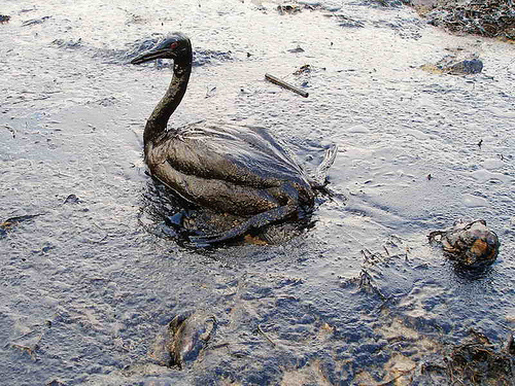Biological Impacts of the Sand Berms
The proposed sand berm system would dredge sand primarily from a group of barrier islands called the Chandeleur Islands. The seafloor immediately off the coast of these islands constitutes an important feeding and reproduction area for many of the area’s fish species (Burdeau).
Opponents to the plan argue that the Chandeleur Islands were decimated by the storm surge of hurricane Katrina, and have yet to fully recover. Plans for rebuilding the islands using sand dredged from other areas have never been enacted, and now the sand berm construction project intends to dredge the seafloor. An excerpt from an article written by Dahr Jamail of the Global Researcher shows the comments of one respected oceanographer, "Dr. Stephen Cofer-Shabica is an oceanographer in South Carolina, who focuses on the biology of barrier islands. According to Dr. Cofer-Shabica, the so-called fix is actually a hugely destructive problem. ‘From an oceanographic perspective, this was biologically destructive, especially when you start digging up the bottom in shallow water, and building these sand berms’ ” (Jamail).
A New York Times article written by James McKinley states that “Gregory W. Stone, director of the Coastal Studies Institute at Louisiana State University, said that dredging and pumping large amounts of sand amid Louisiana’s complex inlets and bays could harm ocean life. Dr. Stone said any plan required closer study before it is put in place. “I understand that time is of the essence, but I really think that we’re taking a gamble here,” he said. The general idea of protecting the area’s vulnerable wetlands by buffering coastal islands with dredged sand is not particularly controversial. Similar plans have been in the works for years, and small-scale projects have had success in the recent past” (McKinley). Dr. Stone’s concerns echo those of many researchers involved with the EPA who have expressed concern that storm surges could wash this dredged sand inward and further degrade salt marshes and other ecologically important areas.
Proponents of the plan to construct a system of protective berms out of sand dredged from the Chandeleur Islands cite the opinion of another source mentioned in McKinley’s New York Times article “’The concepts behind this are probably sound,’ said Denise J. Reed, a wetlands expert and interim director of the Pontchartrain Institute for Environmental Sciences at the University of New Orleans. ‘One of the reasons we’re so worried about the oil coming into the marshes is the barrier islands are so degraded. We don’t have a very intact shoreline’” (McKinley).
Opponents to the plan argue that the Chandeleur Islands were decimated by the storm surge of hurricane Katrina, and have yet to fully recover. Plans for rebuilding the islands using sand dredged from other areas have never been enacted, and now the sand berm construction project intends to dredge the seafloor. An excerpt from an article written by Dahr Jamail of the Global Researcher shows the comments of one respected oceanographer, "Dr. Stephen Cofer-Shabica is an oceanographer in South Carolina, who focuses on the biology of barrier islands. According to Dr. Cofer-Shabica, the so-called fix is actually a hugely destructive problem. ‘From an oceanographic perspective, this was biologically destructive, especially when you start digging up the bottom in shallow water, and building these sand berms’ ” (Jamail).
A New York Times article written by James McKinley states that “Gregory W. Stone, director of the Coastal Studies Institute at Louisiana State University, said that dredging and pumping large amounts of sand amid Louisiana’s complex inlets and bays could harm ocean life. Dr. Stone said any plan required closer study before it is put in place. “I understand that time is of the essence, but I really think that we’re taking a gamble here,” he said. The general idea of protecting the area’s vulnerable wetlands by buffering coastal islands with dredged sand is not particularly controversial. Similar plans have been in the works for years, and small-scale projects have had success in the recent past” (McKinley). Dr. Stone’s concerns echo those of many researchers involved with the EPA who have expressed concern that storm surges could wash this dredged sand inward and further degrade salt marshes and other ecologically important areas.
Proponents of the plan to construct a system of protective berms out of sand dredged from the Chandeleur Islands cite the opinion of another source mentioned in McKinley’s New York Times article “’The concepts behind this are probably sound,’ said Denise J. Reed, a wetlands expert and interim director of the Pontchartrain Institute for Environmental Sciences at the University of New Orleans. ‘One of the reasons we’re so worried about the oil coming into the marshes is the barrier islands are so degraded. We don’t have a very intact shoreline’” (McKinley).
Copyright, 2010 Coastal Environments Class, Kyle Baldwin, Nicholis Jones, Kyle Ribeiro, Constantin Sullivan, Dr. Gaytha Langlois, Bryant University (Smithfield, RI)




